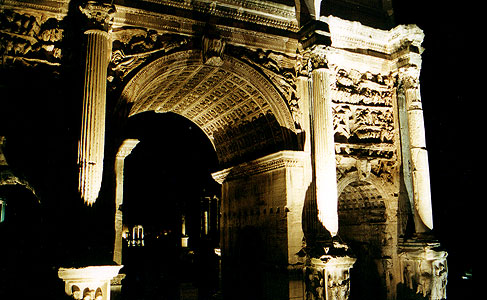
Rome is overwhelming, large and dirty and loud, with all the subtlety of a herd of schoolchildren freed for summer vacation. The retired Center of the World, Rome is an aging woman gathering a lifetime of memories close, treasuring each one while her great-grandchildren roll their eyes and turn up the volume on their Discmen. It is the crumbling home of ancients and a thoroughly modern city, living over and among 2500 years of recycled rock and history.
The first thing I learned: I will never, never drive anything anywhere for any reason while in Rome. On our first afternoon in town, having finally found the hotel despite the concierge's befuddled directions, we caught a cab to Trastevere (the "bohemian" part of town). I inadvertantly ended up in the front seat of the taxi and, as the driver fled the curb, I knew we could not possibly arrive intact.
|
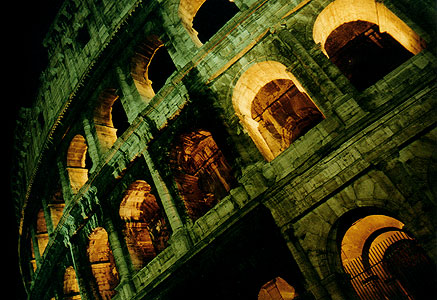
There are no lines on Roman roads, you see, no fixed number of lanes. If you believe you and your vehicle can fit in a given space, you are welcome to try, at any speed. Even when it should, traffic never actually stops moving; at stoplights, everyone jostles like animal cookies settling in the bottom of the bag, constantly creeping forward into the small space left by a neighbor's slight movement.
Naturally, we walked back from Trastevere. But then, that was the point: a flood-lit ramble to counter the first impressions of noise and dirt. We wandered, soaking up the romance of myth and history, visiting small ancient churches and thundering Baroque fountains. The arches of the Colosseum glowed with floodlights; the columns of the Pantheon stretched blackly into the night. We threw our coins into the Trevi fountain (over the shoulder, eyes closed, one for a wish, a second to return to Rome someday), and at the Spanish Steps we let the bubbles in the champagne gelato go to our heads.
|
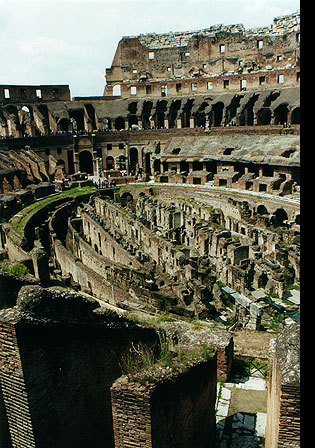
If Florence is Intellectual Western History, Rome is Physical. Here it's not about ideas but about buildings and blood, aquaducts and Caesars, gladiators and thumbs up or down. It's about rise and fall and rise again. It's about stealing the present from the past.
Modern Rome sits atop Ancient Rome, wrapping around, burying, exposing. Ancient columns support an active office building. An unlabeled statue stands atop a pedestal pieced from miscellaneous rubble. Rome is littered with reminders of all the centuries, the lives, the power that came before, all gone now.
Modern Romans seem nonplussed. Columns two millenia old are just columns doing their job, nothing to ooh and aah over. Perhaps Romans are more comfortable with mortality than we young, fast Americans. In the States, we can't stand to let things get old; everything must be shiny and new for it to have any value. What is it like to live constantly with the reminders of the unstoppable march of Time, the impermanence of human endeavors, our own mortality?
Perhaps it doesn't look like impermanence to Romans. The 2000 year old Colosseum is no longer the sporting arena it was, but it's still standing, most of it. It's been plundered for building materials, like most ruins in Rome, but you can wander inside, sit on the benches, listen to the memory of roaring spectators rumbling under the babble of tour groups. The wooden floor is gone, and feral cats wander freely in the basement, visiting the crumbled cages where lions once waited to be lifted into battle with gladiators.
|
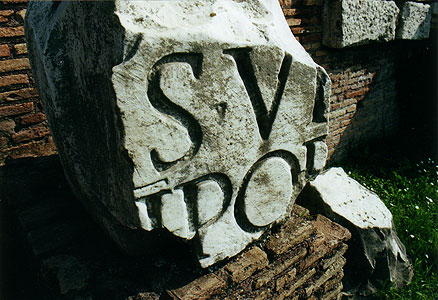
So much energy and so many resources dedicated to death. Today we like to think of life as a sacred thing. Standing in the Colosseum, I wondered if life was as sacred to ancient Romans. Were they more comfortable with the concept of Death than we are today? Was it only the lives of Citizens and the wealthy that mattered, while the lives of Others were expendable for entertainment? With our modern devotion to athletes, our fascination with brutal sports (hockey, football, soccer, the WWF) how close are we, who think we are so much more advanced than the Romans of history, to lining up, paying the ticket price (or having the government pay it to keep us under control), cheering a bloody death match, then lining up again for more?
|
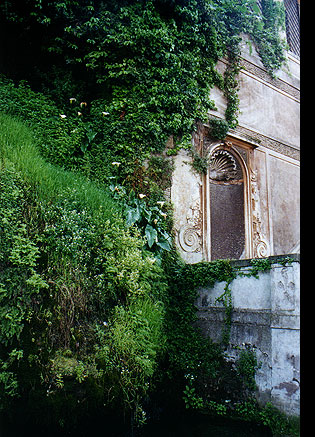
We returned to the Colosseum the next day to follow what our guidebook called the "Ceasar Shuffle," a walk through the excavated ancient Forum along the Via Sacra, the parade route for triumphant generals, to see the highlights of Ancient Rome. We explored the silent Curia, where the Senate once debated, admired the remaining eight columns of Saturn's temple, and climbed the steps Marc Antony stood upon to give his eulogy to a murdered Julius Caesar. As we left the Forum, we stopped to smell the roses running rampant over the ruined home of the Vestial Virgins before heading off to pay the the lire to light Michelangelo's Moses at St. Peter's in Chains. A group of nuns seemed to be on the same itinerary as we; we met them at the Forum, at St. Peter's in Chains, and later at the Pantheon. I joined them in line at the public restroom at the Forum, where they had claimed not only the ladies room, but the men's as well. When Ian arrived, they all dissolved in fits of giggles.
Up on the Palatine Hill, the gardens of the emperors are riotous with flowers and cats and orange trees heavy with fruit. My favorite spot was a two-story fountain that's been bubbling since Julius' day. The upper level is lost under the green drapery of plants who have never known a dry day; downstairs, the fountain is carefully growing stalagtites. I sat watching shy goldfish and reveled in this oasis in the midst of commerce, ambition and victory parades.
|
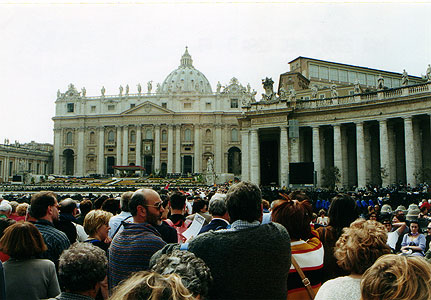
St. Peter's Basilica (left) wants to be such a place, a quiet retreat from the bustle of living. But as the largest church in the world and the center of Catholicism, one of the world's largest and most powerful religions, quiet and reflection seem very far away. This isn't to say it's not impressive; in a city of impressive structures, this one makes your jaw drop. It is enormous as you exit the taxi at the far edge of St. Peter's (elliptical) Square, and it only gets bigger as you approach through the mobs of people.
St. Peter's is a destination for pilgrims, one of the holiest places in Catholicism, and 2000 was a pilgrimage year. The Basilica has five front doors, with one usually bricked up on the inside. Once every 25 years, the Pope opens this Holy Door for a Jubilee Year. Based on an Old Testament tradition of forgiving debts and freeing slaves every fifty years, the modern Jubilee is a year-long special on forgiveness. Catholics come to Rome, make a confession, receive Communion and earn an indulgence, "the extra-sacramental remission of the temporal punishment due," (from the Catholic Encyclopedia). Who'd have guessed the fare for a trip to Rome could be measured in Our Fathers?
|

We stood, tourists and pilgrims alike, in the world's most orderly queue, waiting our turn to brush the bronze knees of Jesus as we passed through the Holy Door. A group of nuns in front of us recited, "Ave Maria, gratia plena..." with every step forward. The youth group beside us sang praise songs; the tunes I recognized, the words I didn't. Behind us, Italian grandmothers quietly fingered their rosaries until we rounded the last corner. Inspired by the sight of their destination, they crowded forward, wedging us like so many wiggling sardines. It is only because I am head and shoulders taller than all Italian grandmothers that I did not pass out in the crush and the sudden exit of anything passing for oxygen. Even if I had, I probably would not have fallen.
There were too many pilgrims and tourists and grandmothers squishing through the door; I could not reach Jesus' knees.
And suddenly, as we spurted through, the crush of people disappeared into six acres of blissfully empty space. It's one thing to stand in line aware that St. Peter's is the largest church in the world; it's a completely different thing to step inside and know what that looks like.
|
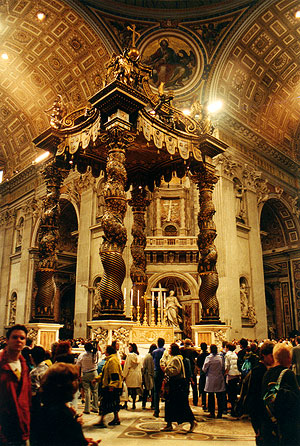
The cherub with the bowl of holy water at the first pair of columns is taller than I, and considerably rounder. The canopy over the main altar is seven stories tall. Each of the gold letters marching around the lower rim of the dome is six feet from top to bottom. And the dome itself, built by Michelangelo, is 138 feet across and peaks nearly 400 feet above the floor. We passed on climbing to the top of the dome to wave down to the ant-sized people wandering in the vastness of St. Peter's. It was completely unnecessary; such is the scale of the basilica that merely standing floor-level made me feel very small and ant-like.
For something that required more than 100 years and several different artists and architects to create, the interior of St. Peter's is surprisingly coherent. Most of the other cathedrals I've seen are rather jumbled, especially inside. Each generation has left a mark, in whatever style was in vogue at the moment. St. Peter's, however, is a symphony in pink and gold: a Baroque vision of Heaven.
It was a vision which did not make me think about God at all. St. Peter's is a beautiful, breathtaking display of the power and wealth of men. Built and decorated during the Counter-Reformation, it is supposed to impress the lowly worshiper with the blessedness, the rightness of the Catholic Church, the Church ordained by God when Christ said to Peter, "You are Peter, and on this Rock I will build my Church." Somehow, I think Peter the humble fisherman would have built a different church.
|
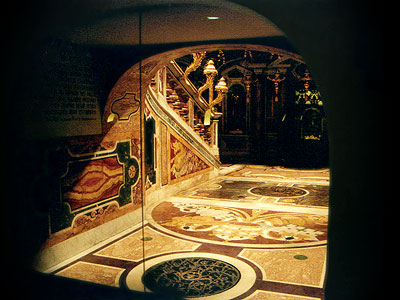
We exited St. Peter's via the crypt before any more of my Protestant roots could show. Peter is supposed to be there; the historical location of his grave was the center of the original St. Peter's, a church built by Constantine in 343 and carried from the new St. Peter's in pieces so the Basilica could place its high altar over Peter's bones. (Archeologists in the 20th Century, finally permitted inside the crypt, found First Century male remains in the late 1940s; they were controversally identified as Peter's in the late 60's.) Peter shares the crypt with various royals and many popes, each buried in lavish monuments. Is there a tomb prepared for the current Pope? How strange to live and work and know that in the building next door there's a marble box waiting for your body and your efigy. How does an intimate familiarity with your final resting place change your view of life and mortality?
|
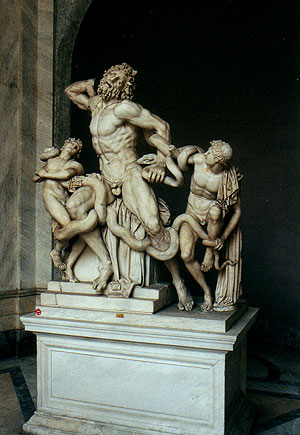
After our time in St. Peter's, it was simply impossible to visit the Vatican Museum on the same day. We came back the next day to hike through the quarter-mile hallways linking several Papal palaces built on a scale appropriate for the "heirs" of the Roman Emperors. Despite the arguments regarding the appropriateness of such pomposity, I still have to be grateful. In its belief in its own regalness, the Church collected and preserved the art and artifacts of the ancient world, things that otherwise would have surely been lost to modernity during the Dark Ages. Here are the Classical statues whose balance, grace and perfection inspired the art of the Renaissance. Here also is Laocoön (at right), whose movement and emotion taught Michelangelo.
In addition to these pagan works, safely out of the public eye to ensure the death of the old gods, the Vatican Museum hosts miles of halls and rooms of Church Art. In the Sistine Chapel, a quiet place of prayer and reflection, packed with hundreds of whispering tourists and security hissing, "Shh!" Michelangelo's powerful frescos celebrate the beauty of creation and the terror of judgement. His work has roots deep in the Middle Ages, when art's purpose was to tell the stories of faith to the illiterate masses. Once Guttenberg invented the printing press and more and more people learned to read, the Church still sponsored painting continued; there are even several rooms of Modern Art. Is the purpose now still to educate and inspire faith? Or is the art like the praise songs I sang at Vespers at Westmont: something soothing to make you feel better while hiding the complexities of the modern world, something to dull the pain and keep you from asking too many questions?
|
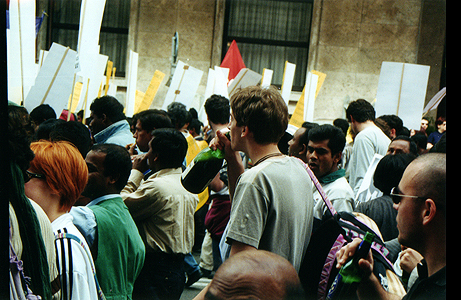
We awoke the next morning to the sound of chants and exhortations blurred by a PA system. May Day, evidently, is a very special day of protest. We found the endless rally on our way to the train station, protesters waving posters of Martin Luther King, Jr., Malcolm X and Che Guevara and carrying banners for Nouvo Sociolismo. The chant echoed, "Sanatoria, Libertas!" (Cleanliness is freedom? Health care and libraries?). Racks of speakers strapped on top slow moving vehicles rattled the neighborhood with the rhetoric of protest leaders exhorting the participants and the sidewalks of on-lookers.
The problem, or benefit, of routing your protest march by the train station is the tourists. We noticed several young men, not appearing to share much of the heritage of the official participants (primarily Africans, Kurds and Croatians, if the signs were any indication), wearing backpacks and moving with that stiffness you get after being on a train for a few hours. Many carried vino, and, dispite the hour, many bottles were open.
Ian's camera attracted the attention of someone, bystander or participant, who asked if Ian was a journalist. How to respond? No, we're not connected with a paper? Yes, this will get written up online? I don't think we explained very well.
|
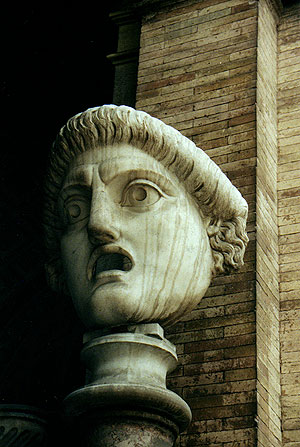
We waded through the protesters to the train station, heading out of town. The train to La Spezia was oversold; we couldn't find normal seats so we perched at the counter in the dining car. Once we purchased something, the officials left us in peace (we ate our prepackaged pastries very slowly) to ruminate upon Rome.
I think visitors to the Eternal City are supposed to be impressed by the grandeur of history, the feats of our predecessors. And while it is certainly impressive, I seemed to ponder more the ceaseless progress of time and the futile struggles of humanity to resist oblivion. Massive monuments to dead men, Christian and pagan, fill the city, and we moderns often recognize only the monument, forgetting who built it or why. It's just some old tower, building, arch, statue, fountain, or tomb; our eyes slide over, dismissing it, and the builders have failed in their shot at immortality.
Still, the ancient Romans as a group seem to have succeeded. Their structures still stand, their letters form our alphabet, their language is the root of Italian, French, and Spanish. Their early government inspired contemporary representative democracy. And Rome is a model for contemporary society. We know how it started and how it ended. If we Americans want to know where we might be going today, where our increasingly distant government, our military involvement in places far from home, our expanding appetite for novelties and imports, we have only to look to Rome. May we learn from history before we repeat it.
|

